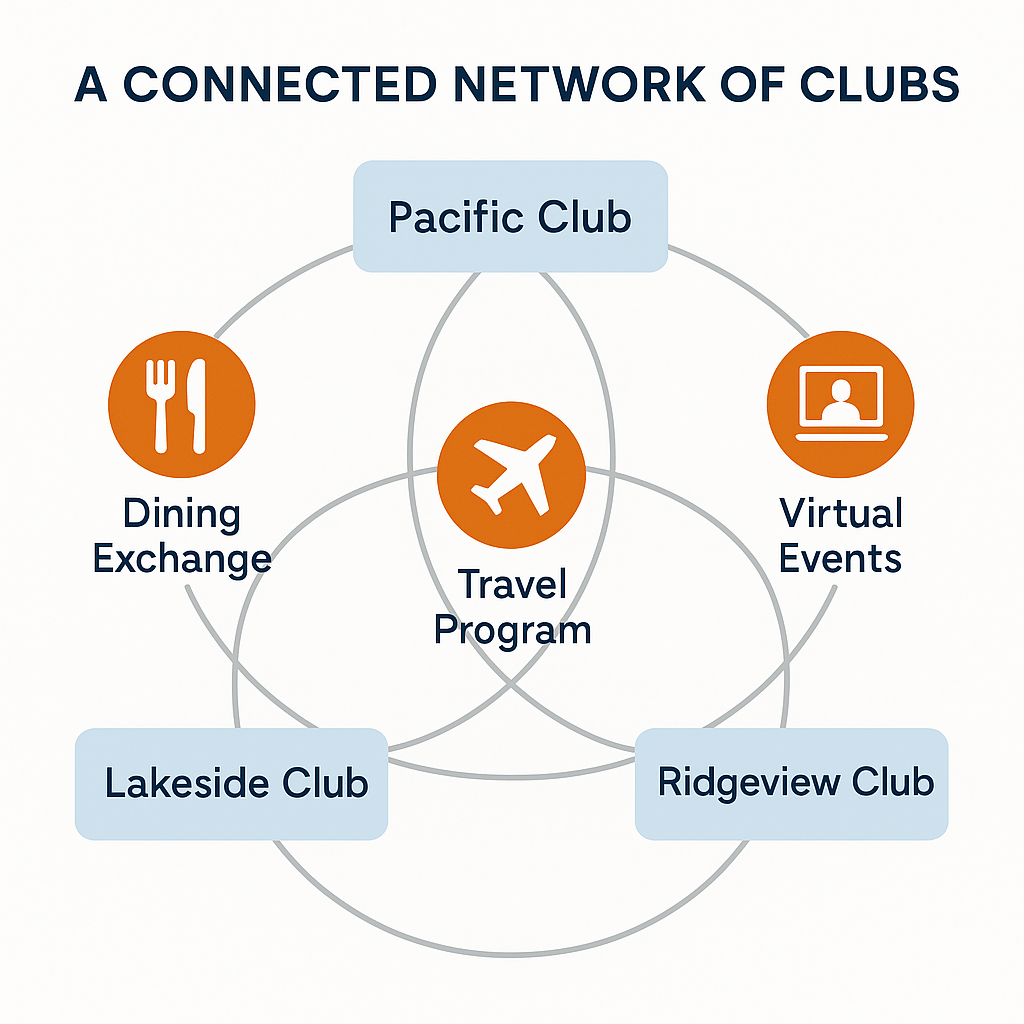
Executive Summary
Private social club members today want more than a beautiful clubhouse and familiar faces. They crave connection, access, and experiences that stretch beyond a single location. Forward-thinking clubs are responding by creating cross-club experiences: partnerships that allow members to enjoy other clubs’ amenities, travel programs, or virtual events under a shared ethos of exclusivity.
This article explores why these collaborations are becoming essential, what forms they can take, how to structure them for success, and the long-term benefits of creating a networked lifestyle that goes wherever your members do.
Why Cross-Club Experiences Resonate
Modern club members live differently than they did a generation ago. They travel more frequently, work remotely, and spend more time exploring new destinations and experiences. According to the 2024 Financial & Operating Trends in Private Clubs report by RSM, nearly half of surveyed clubs cite evolving member expectations as a top operational challenge. The private club that can meet evolving needs without requiring members to leave the community will hold their loyalty for years to come.
Cross-club partnerships give members that freedom. Whether it’s enjoying dinner at a partner club during a business trip or joining a multi-club wine retreat, the idea of seamless belonging wherever they go creates a deep emotional tie to their home club.
It also reframes how members see value. Instead of a static membership, they feel part of a living, breathing network of like-minded people who share their values and lifestyle. That network effect turns membership into something aspirational.
And for the club itself, the benefits are just as strong:
- Increased retention. Members who experience fresh offerings and broader privileges are less likely to look elsewhere.
- Enhanced brand reputation. Being part of a curated network elevates prestige.
- Deeper engagement. Cross-club events encourage more participation, more social sharing, and stronger emotional connections.
In short, cross-club experiences transform your membership from a single location into a lifestyle brand.
5 Inspiring Types of Cross-Club Collaborations

The private club industry contributes billions annually to the U.S. economy, and initiatives like cross-club experiences play a key role in sustaining that growth, according to new data from the CMAA, Club Benchmarking, and the National Club Association. When club owners work together, the results can be creative, rewarding, and easy to implement. Here are five proven ways to collaborate that appeal to today’s members:
1. Culinary Swaps
Invite chefs from partner clubs to trade kitchens for a week, giving each club’s members the thrill of new dining styles without leaving home. Visiting chefs can host themed dinners or cooking classes, bringing fresh ideas and energy to your culinary program.
2. Regional Travel Itineraries
Create a multi-club travel circuit where members visit several partner clubs over a weekend or holiday. For instance, clubs across Texas could design a Hill Country wine-and-dine tour, or golf clubs might host a three-course tournament across multiple courses.
3. Destination Retreats
Partner with clubs in other states or countries to offer annual retreats or seasonal experiences: ski trips, sailing regattas, or vineyard harvest weekends. Members gain access to unique experiences that reflect the network’s collective culture.
4. Virtual Member Series
Offer digital collaborations such as shared speaker events, virtual wine tastings, or online workshops. This keeps members connected year-round, even when travel isn’t possible, and brings an innovative edge to your member engagement strategy.
5. Guest Access and Lifestyle Exchanges
Allow select members to visit or book overnight stays at partner clubs through a reciprocal reservation system. This enhances travel convenience, reinforces brand loyalty, and provides a more personal experience than typical reciprocal access.
These programs build excitement and deepen the sense of community without requiring major infrastructure or investment.
Example of a connected club network highlighting dining exchanges, travel programs, and virtual events between partner clubs.
How to Structure Partnerships
Building a successful cross-club program takes more than a friendly agreement. The most effective collaborations operate under clear goals, consistent standards, and reliable communication.
Define the Purpose
Start by aligning on why the partnership exists. Common goals include:
- Enhancing member value and retention
- Differentiating the club within a competitive market
- Promoting cultural exchange between clubs with shared values
- Offering members new lifestyle experiences
Being explicit about objectives ensures both clubs invest with intention and measure success accordingly.
Determine Access Levels
Next, define who has access and how it works. Will all members be eligible, or only certain membership tiers? Are these privileges seasonal or ongoing?
Some clubs adopt a tiered model: base members receive access to select reciprocal benefits, while premium members enjoy higher-touch experiences like dedicated travel planning or exclusive event invitations. This approach can also create an upsell opportunity within your membership structure.
Set Clear Logistics
The operational side can make or break a partnership. Early planning helps avoid confusion later. Consider:
- Booking process: How will members reserve experiences? Through your front desk, an online portal, or direct club-to-club contact?
- Billing: Will the host club bill the guest directly, or will the home club handle payment and reconciliation?
- Communication: Create shared branding and consistent messaging across both clubs’ newsletters and social channels.
Some clubs use shared calendars or booking apps to streamline logistics, while others integrate a white-label member app to make reservations seamless. Whatever system you choose, clarity and consistency are key.
3 Tips for Marketing Cross-Club Experiences to Members
Even the best partnership will fall flat without strong storytelling. Members need to see and feel the value, not just read about it.
Tip #1: Create the “Insider” Narrative
The best marketing approach highlights exclusivity and connection. When promoting cross-club opportunities, focus on the insider experience: what members will discover that’s not available to the general public. Use storytelling to paint the picture: the chef who learned new techniques in a partner’s kitchen, or the group of members who met on a cross-country wine trip and became lifelong friends.
Photography and video can elevate this narrative further. Capture authentic moments of connection rather than posed marketing shots. Insights from Private Club Marketing’s Future of Private Clubs report show that storytelling and exclusivity are now among the most effective engagement drivers for next-generation members.
Tip #2: Personalize the Promotion
Use your member data to recommend experiences based on interests. If you know certain members enjoy golf, wine, or wellness, tailor invitations that align with their preferences. A well-timed email or personalized message from the GM can dramatically increase participation.
Tip #3: Use Multi-Channel Communication
Marketing your club and reciprocal club benefits is key. Highlight upcoming experiences across newsletters, websites, social media, and in-club signage. Many clubs find success featuring “Member Spotlights” that recap past trips or events, showing others what they might be missing.
Also consider adding a Cross-Club Experiences section to your member portal or app, where upcoming collaborations are listed with RSVP options and photo galleries from prior events.
What Is the Long-Term Impact of Cross-Club Collaboration?
When executed well, cross-club partnerships can transform a club’s brand and member culture in lasting ways.
Builds Prestige
Being part of an elite network signals quality, sophistication, and modernity. Members take pride in belonging to a club that offers them access to a curated lifestyle. This prestige also attracts new members seeking more than local amenities—they’re looking for belonging within a larger, aspirational community.
Encourages Deeper Engagement
Shared experiences, especially those that involve travel or collaboration, create stories members love to tell. These moments spark connection and bring energy back to your home club. Over time, it fosters a richer sense of community that strengthens loyalty and participation. Research published in ScienceDirect’s study on the relational benefits of private club membership supports the idea that shared experiences increase loyalty and long-term member satisfaction.
Expands Word-of-Mouth Referrals
When members visit other clubs or attend joint events, they naturally share those stories with friends and colleagues. Those stories often lead to new member referrals across the network, effectively turning every participating club into an ambassador for the others.
Inspires Innovation
Exposure to different club cultures encourages your team to think creatively about programming, amenities, and member service. Seeing how another club approaches events, technology, or hospitality can inspire improvements within your own operations.
Ultimately, the most successful cross-club networks operate as ecosystems. They share ideas, talent, and members, all while preserving each club’s unique identity.
Frequently Asked Questions
How do we find the right partner clubs?
Start with clubs that share your brand values, target demographic, and member expectations. A cultural fit matters more than geography. Reach out to peers through associations like CMAA or the Club Intelligence community to identify potential matches.
How can smaller clubs participate in cross-club programs?
You don’t need a large network or big budget. Begin with one or two clubs nearby, focusing on low-cost collaborations such as chef exchanges, co-hosted charity events, or virtual member talks.
Should we charge members for cross-club experiences?
Some experiences are included as a member benefit, while others, like travel events, are fee-based. Transparency is key. Make sure members understand what’s included and what’s an optional paid enhancement.
How can we ensure consistent member service across clubs?
Develop shared service standards or event guidelines with your partner clubs. Train staff on mutual expectations, ensure clear communication before visits, and gather feedback after each experience to maintain quality.
What tools can help manage cross-club logistics?
Several clubs use member management platforms or event apps that sync calendars, manage RSVPs, and automate communication. Simpler options include shared Google Sheets or private event dashboards integrated into your website.
Bringing It All Together
Creating cross-club experiences doesn’t give away your club’s exclusivity. In fact, it amplifies it. When done thoughtfully, these partnerships transform the member relationship from transactional to experiential.
Start small. A single shared event or guest-chef dinner can evolve into an ongoing network of partnerships that expands your club’s reach and reputation. The result is a membership experience that feels dynamic, modern, and deeply connected.
Join the Club Intelligence community to explore more strategies like this, connect with other club owners, and share your own cross-club success stories. Visit clubintelligence.com to join for free.




